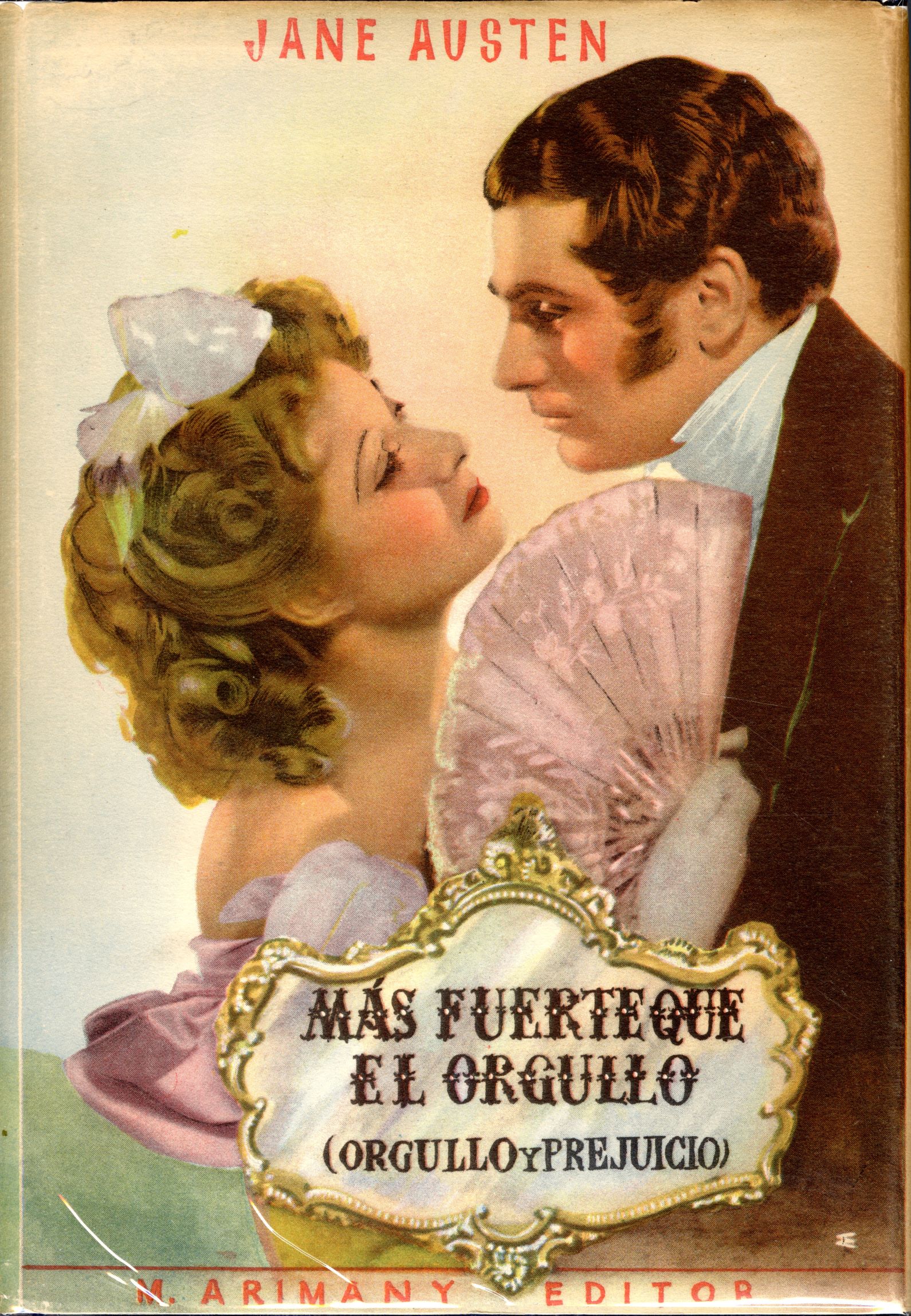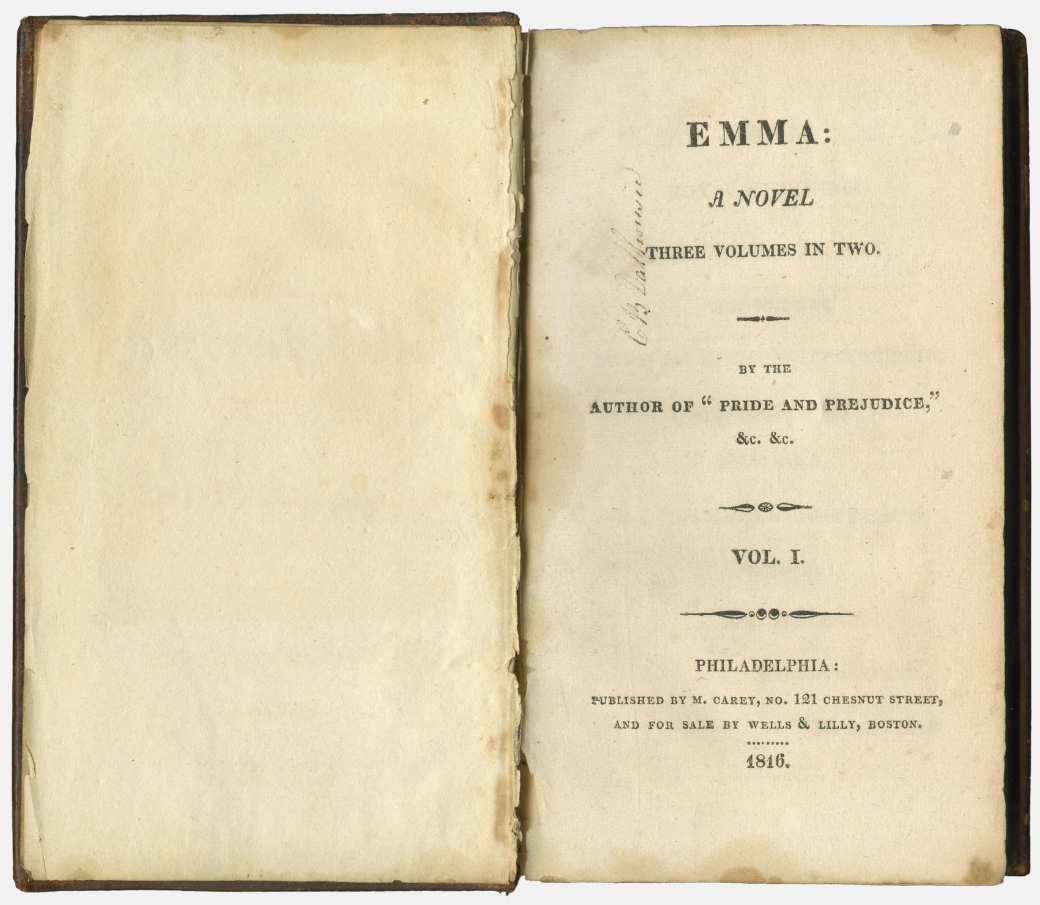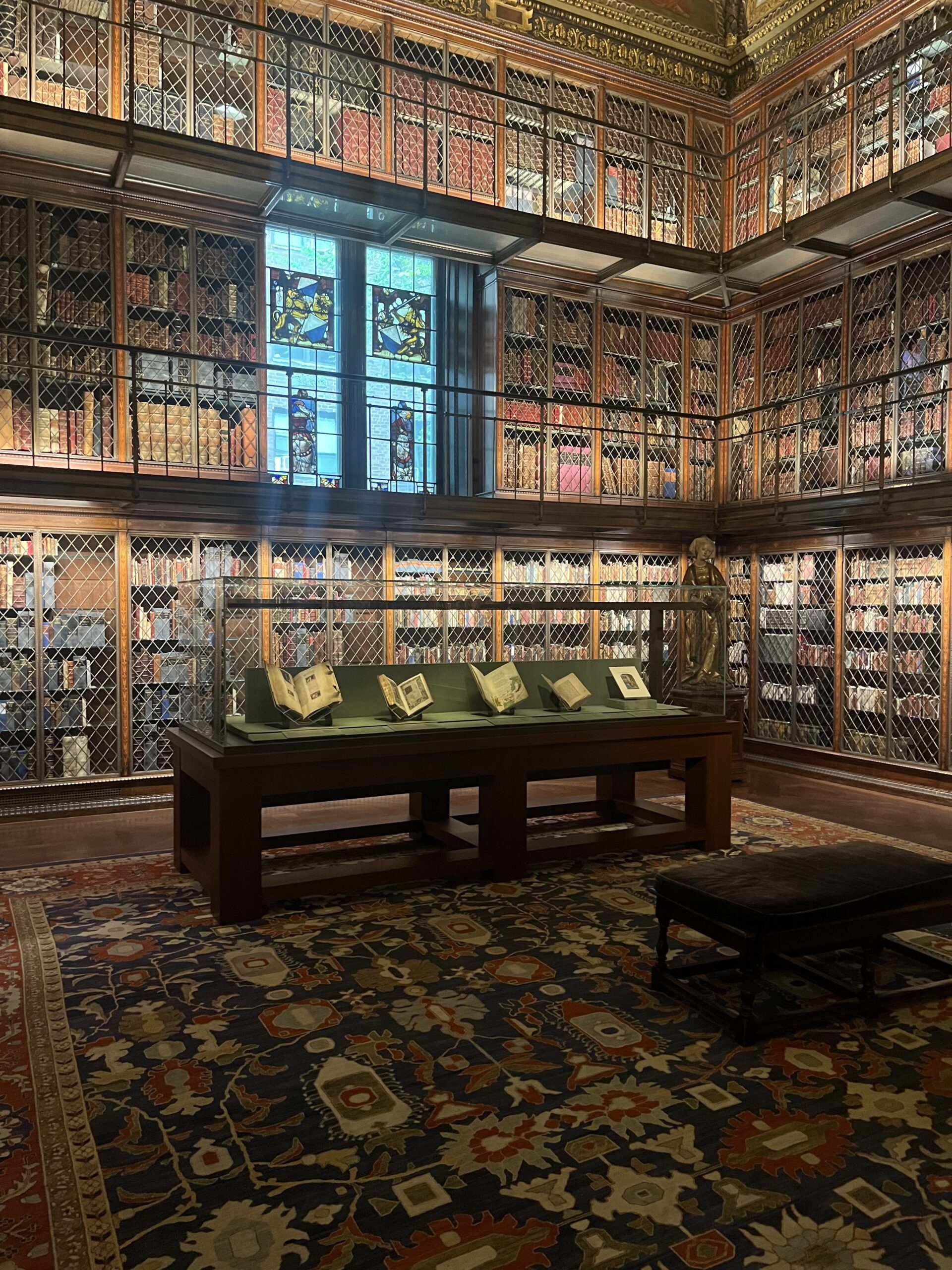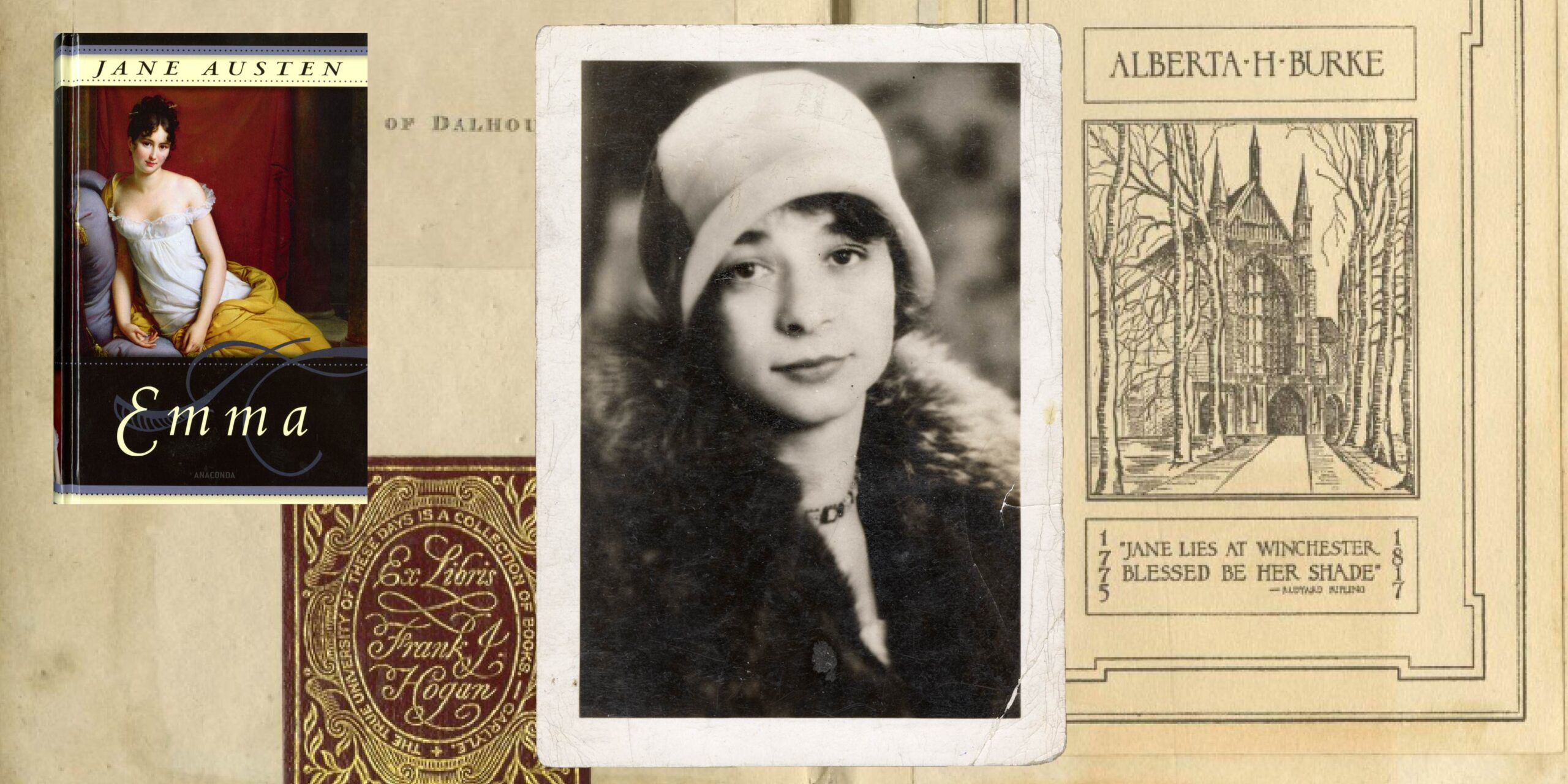Alberta Hirshheimer Burke 1928, described as introverted by her family, loved literature, and she loved Rudyard Kipling. While a student at Goucher, she read Kipling’s story “The Janeites,” about World War I soldiers who bond over their love of Jane Austen, and she wanted to know more. As Burke later wrote to her friend Averil Hassall, “When I read it I resolved to investigate an author of whom my favorite thought so highly, and I’ve been entrapped ever since.”
This look at how Burke became a collector of Jane Austen books and materials is featured in the Goucher student-curated exhibition By a Lady: Alberta Burke, Jane Austen & the Art of Collecting. The exhibition, prepared by students in Professor Juliette Wells’ Jane Austen Archives Practicum course, is on display in the library’s Collaborative Humanities Exhibition Space until March 13, 2026. “The students chose what they wanted to focus on, how they wanted to organize it, which quotations they wanted to highlight,” says Wells. “They designed posters, wrote the object labels, chose the fabric. Everything that goes into an exhibition, they did, along with my help and guidance.” One of the most striking elements of By a Lady is the display of colorful book covers from translations into Danish, Japanese, Arabic, and seven other languages, some of them reminiscent of paperback romance novels. The covers are facsimiles produced by the students, as it would damage the actual books to leave them on display. Instead, the originals are kept safely with the rest of the collection in the closed temperature-controlled storage area.

The student exhibition is part of a larger celebration of all things Jane Austen at the college. That’s because this year, Goucher celebrates two significant anniversaries: It has been 250 years since Jane Austen’s birth, and it has been 50 years since Burke bequeathed her collection to Goucher, a collection that includes more than 1,000 volumes and more than 40 boxes of materials.
Burke’s 1975 bequest to Goucher was—and remains—the largest Jane Austen collection in North America, one that is second only to that at Jane Austen’s House, the museum in Austen’s former home in Chawton, England. Goucher’s collection holds first editions of Austen’s novels, including the only one published in America during Austen’s lifetime, the 1816 Philadelphia Emma. The collection has continued to grow through other donations over the years, and today consists of rare and illustrated editions, dozens of translations into different languages, and even adaptations like Pride and Prejudice and Zombies and Sense and Sensibility and Sea Monsters.
There are also 10 scrapbooks created by Burke filled with 20th-century ephemera, like newspaper clippings that mention Austen and playbills from theatrical versions of her work, as well as Burke’s correspondence with Austen bibliographers, booksellers, and her friend and fellow Janeite Averil Hassall. “You can really see Alberta Burke [in the items], who she was as a person,” says Kristen Welzenbach, Goucher’s Special Collections and Archives curator. “She was very feisty and very protective of Jane Austen and wanted her to have her rightful place in literary history.” The scrapbooks are incredibly fragile, so Special Collections has been painstakingly digitizing them. “We’re putting the final touches on them, and they will be open for people to look at and research as PDFs in September,” Welzenbach says.
As By a Lady explains, Burke began seriously collecting Austen works and ephemera in the mid-1930s. Wells, an Austen scholar who has published three books exploring Austen’s readers and fans, says that at the time it wasn’t prohibitively expensive to buy Austen’s first editions and letters to friends and family. She was a beloved author, but her popularity was nowhere near what it is today. In fact, after a Pride and Prejudice film was released in 1940, there were no big screen adaptations of an Austen novel until Sense and Sensibility in 1995. That year was a significant one for Austen fandom, according to Kaylee Ray-William ’25’s exhibition, Celebrating 1995: The Year That Made Jane Austen a Star, which is on display in Goucher’s library next to By a Lady. 1995 also gave the public the BBC’s Pride and Prejudice miniseries, its TV film version of Persuasion, and Clueless, the modern take on Emma. “It was a year that made Austen fans out of people who hadn’t necessarily read her novels,” says Wells. Austen’s popularity exploded, and it hasn’t died down since.
In addition to the student exhibitions, Goucher’s year of celebration also features two library artists in residence, who will open an exhibition in Goucher’s library in August. MICA faculty members Victoria Pass, a fashion historian, and Lauren Frances Adams, a studio artist, have been engaging with Goucher’s Jane Austen collection to create their own pieces and produce the exhibition as a celebration of Austen’s 250th birthday. “I have no idea what to expect,” says Welzenbach. “I’m really excited about that, because I think it will be fascinating to see the collection through the artists’ interpretation.” Special Collections & Archives will hold an open house for visitors to view the artists’ exhibition and materials in the collection on October 28, from 5 to 7 p.m., on the fourth floor of the Athenaeum.
Then, on September 13, Goucher will host a day of events for alumni and others to celebrates the two anniversaries, called “If I Loved You Less: Celebrating Jane Austen’s 250th Birthday and the 50th Anniversary of the Goucher College Jane Austen Collection.” The first session, which was already sold out by early spring, involves a birthday tea with sandwiches and desserts, a talk by an author of a cultural history of Jane Austen fandom, and a tour by Welzenbach of Goucher’s Jane Austen collection. There will also be workshops with the Jane Austen Society of America (JASNA) Maryland chapter, dinner, trivia, and dance lessons, topped off with an English country dance hosted with the Baltimore Folk Music Society.
Burke’s love of Austen is being commemorated outside of Goucher this year, as well. She also left some of her large collection to the Morgan Library in New York, which invited Wells to co-curate an exhibition on Austen with Morgan curator Dale Stinchcomb. That exhibition, A Lively Mind: Jane Austen at 250, is open until September 14 and has gotten great reviews from The New York Times, Observer, The Wall Street Journal, and many other publications. Wells, who also wrote an introduction for a Mansfield Park edition coming out this fall, was given plenty of freedom in putting the show together; she wrote all of the texts and recorded the audio guide. She also collaborated with the Morgan curators to choose all the objects and determine the order of presentation.
The show is distinct from the Morgan’s previous Austen exhibitions in that it features loan objects. Goucher loaned 46 items from its collection, including its 1816 Emma and many translations. It’s the biggest loan from the Jane Austen collection that the college has ever made. “This exhibition is special because we can tell the story of Jane Austen’s life, and her authorship, and her afterlives, with a broader group of materials,” says Wells. “They also help tell Alberta Burke’s story.” One theme of the exhibition is Austen’s imagination and creativity. “We wanted to emphasize how much courage it took for Austen to aspire to authorship in that time,” she says. “We wanted to emphasize how much persistence and perseverance was required, because she didn’t see any of her novels in print until she was in her thirties, but she had been writing and dreaming of publication since she was in her early teens.”

The exhibition also displays a gold and turquoise ring belonging to Austen, on loan from Jane Austen’s House. “That was bought, in 2012, by Kelly Clarkson, who was then told that she couldn’t take it out of the country because it was an important heritage object,” said Wells. “And she decided, rather than leave it in a vault in England and go and visit it, that she would allow Jane Austen’s House to take up a collection and fundraise to buy it for the house.” This is the ring’s first trip to the U.S.
For Wells, one of the biggest gets—and the largest, as well—is a painting by Amy Sherald, who painted Michelle Obama’s official portrait and lived in Baltimore until a few years ago. Loaned by private collectors, this painting is a portrait of a man titled “A single man in possession of a good fortune,” in a nod to Pride and Prejudice. “You see that title, and the person you’re looking at is a young man of color, who has the stance and the dignity and the confidence of all of Amy Sherald’s portrait subjects,” says Wells. “She’s inviting you to think, ‘How do you imagine those heroes of Jane Austen’s novels?’” Wells has been using the painting in her teaching for several years and really wanted it in the show. She credits her co-curator, Stinchcomb, for working to get it in the show. “It’s great. It’s a showstopper of an ending.”

Passing on that joy of curating to her Goucher students for their own exhibitions is a vital part of Wells’s work. She teaches them to think in a different way about audience. “We talk a lot about how you can’t count on a viewer looking at things in the order that you intend,” she says. “You have to think about the likely knowledge that some visitors will have, what might interest them.” It’s a creative way for students to engage in scholarship, one in which they immerse themselves deeply.
Welzenbach also stresses the importance of putting the collection in the hands of students. “We’re not a museum. We’re set up for students and faculty and classes to come in and use our collections, which we want, and they do,” she says. “The tricky part of it is balancing the care and the needs of the collection while providing access.” Finding that balance is the key to any special collection. “You don’t want to hide it away—you want people to see it.”
Goucher students—along with so many people around the world—find much to love in Austen’s work. Even 200 years later, her humor still lands, and her characters are still relatable. Wells sees a strong sense of morality in her work that appeals to readers. Austen’s work has nuance and layers that reward re-reading, and the stories continue to draw people in. As Wells points out, Austen is not the only writer with these qualities, “but she put it all together in a way that really speaks to people.”
To support the library and its many projects, visit Friends of the Goucher College Library.

